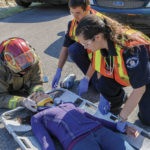When is the Right Time to Call 911?
The most important thing is that 911 is for emergencies only. An emergency is threat to life, threat to injury, immediate threat to destruction of property, any sort of hazardous situation like a gas leak or natural gas spill, fire, and a missing vulnerable person including children.

When you call 911, call takers speak to citizens and decide which resources are needed to deal with the situation at hand. Every situation is unique. Is the ambulance, fire, police or are all three needed? Is it a critical incident or is it a non-emergency call that needs to be referred to local government resources. If a caller is unable to reach a 911 dispatcher for whatever reason, personnel assigned to a call back desk will call back when a line gets dropped before 911 has had a chance to answer. The call back attendant will try to contact every person who tries to call 911. Most call backs are pocket dials and rarely are an actual emergency.
The call taker will ask a number of questions to gather as much information as possible. It is really important to provide good information and history of the emergency to the dispatcher. The information will be passed onto the emergency personnel dispatched to the scene of the emergency. In a medical emergency, for example, the information about the patient (eg. is the person breathing, conscious, bleeding?) will be passed on to paramedics sent to the scene. The same paramedics will then see the patient and add their own history to the patient’s information. They will do a physical examination and take a lot of notes. When they bring the patient to hospital, paramedics will share all relevant history with hospital staff.
What do 911 operators need to know?
The questions that the 911 call taker will ask will depend on the type of emergency. It is very important to answer all questions calmly, patiently and accurately. All questions have purpose and help dispatchers formulate the proper response, number of resources and which resources to dispatch. All the information taken by the call taker is entered into a computer. Everything is tracked by location. Location is the most important information needed by the 911 dispatcher. If the dispatcher doesn’t know where the emergency is, then emergency services personnel will not be able to help.
What should you do if you’re waiting for an ambulance to come?
Firstly, get help from other people, like family or bystanders, nearby. Secondly, stay calm and don’t panic. You will not be able to think clearly and react effectively if you panic. Typically, the caller will stay on the line with the 911 operator until emergency services arrive at the scene. There are lots of things helpers can do to improve outcomes while waiting for EMS. Be prepared by having a fully stocked first aid kit nearby and by keeping your first aid skills current and up to date. First aid and CPR classes are a good investment of time and money and most emergencies occur in the home. You can also download the Red Cross First Aid App in advance for quick tips and access in the event of an emergency. Having first aid knowledge and skills will help you know what to do until medics arrive. Children too can learn first aid by taking age-appropriate training classes with SOS 4 Kids. My Safe Life is for 7-9 year olds. Home Alone Safety for Kids is for 9 – 12 year olds and the Babysitter’s course is for 11-15 year olds. All SOS 4 Kids programs include first aid skills.
Remember that 911 is for emergencies. It is a crime in North America to use 911 for any other purpose. Some examples of a non-emergency call are theft from a vehicle, property damage where suspects have fled scene, a motor vehicle collision where no injuries are reported, and general inquires or complaints about noisy and disruptive amber alerts.

